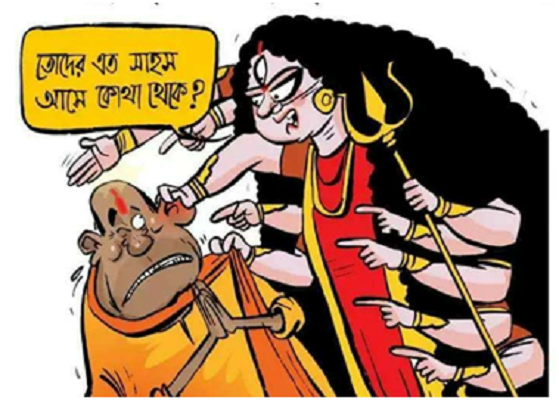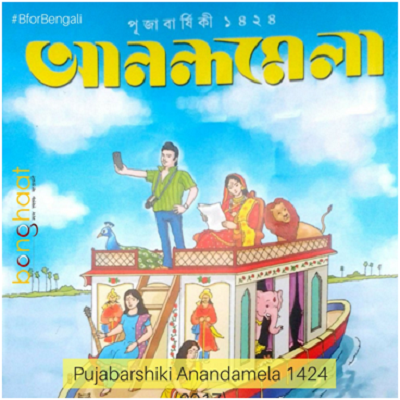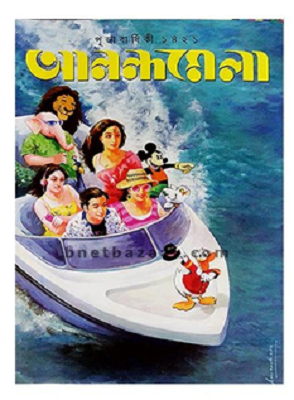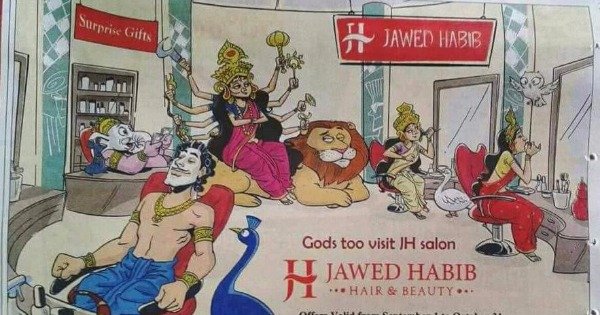It is well known that Durga Puja, as it is celebrated in Bengal, is a carnivalesque festival. Its celebration is markedly different from “Navratri”, or other manifestations of Dusshehra celebrated across the country. The festive mood in Bengal is not steeped in religiosity, but rather, on the revelry that forms the core of the Puja celebrations. To a Bengali, it is more about pandal hopping, new clothes, and good food than about the actual rituals. Durga’s sacrality is not perceived to be under threat even from whacky idols made of biscuits, kulhads, or old records etc.
This spirit of the cultural extravaganza that is Durga Puja was completely missed by the protesters of a print ad depicting Durga and her entourage enjoying in a Jawed Habib salon.
The advertisement which was released in print in Kolkata met with outrage on social media. There was, however, no objection to the ad from its target audience, that is, the people of Kolkata. With a court case being registered in Hyderabad and salons being vandalised in Uttar Pradesh, Jawed Habib took to apologising profusely on Twitter. After multiple tweets of apology, Jawed Habib posted a video of his apology where he pressed all the “right” buttons. He distanced himself from his religion, emphasising that his vocation is his only religion and that he is an Indian. This apology was another sad and sorry instance of the rise of Hindu supremacy in the country.
The absurdity of the right-wingers’ saviour complex in this instance begs to be exposed. In Bengal, Durga’s beauty is an ideal which women aspire to. A commonplace compliment to a woman’s beauty is that she looks like “Pratima” or the goddess. Hence, it was a logical advertising ploy to capitalise on this popular view of beauty for the local Jawed Habib salon by taking credit for beautifying the goddess who provides the benchmark (sic) for beauty amongst Bengalis. Moreover, Hindu gods have had a long tradition of being depicted humorously with human frailties, be it the erotic escapades of Krishna or the gluttony of Ganesh. So, what is so objectionable in Durga enjoying something as harmless as a day in the spa? The stupidity of the controversy becomes more glaring in the backdrop of Puja-advertising in Bengal. Here, the image of Durga is used to advertise everything from alcohol to saree shops. The Jawed Habib ad cannot even be lauded for being innovative in this regard.
As becomes evident from many of the Twitter posts, it is Habib’s Muslim identity which gives the Hindutva brigade permission to take offence at this ad, when it couldn’t do the same with other similar ads. The anger was not directed at the creative team which designed the campaign, or the local salon that commissioned it. It was not them but Habib, who was forced to apologise. Durga Puja in Bengal has had enough on its plate with the impositions made on it by the Chief Minister. These include government sponsorship of certain pandals, infiltration of political campaigns, Didi herself initiating the sacred ritual of painting the goddess’ third eye, etc. Bengalis have taken umbrage at this latest invasion into their festivities, especially by people who do not understand the spirit of irreverence and creative license which is a cornerstone of Durga Puja. It is by now a cliché to protest against the representations of Hindu divinity, be it for art or advertisements. What is noteworthy is that such a protest could be launched when the intended consumers of the advertisement were unconcerned or even appreciative of it. That an apology could be so easily gotten out of Habib indicates the already prevalent reign of fear propagated by the Hindu supremacists.

Also by Dipannita Ghosh:
McOnam Sadhya: Tinkering with Tradition
The Cultural Implications of Privacy in India
All for a Toilet: Propaganda or Social Reality?
#AintNoCinderella: Online Campaign Against Misogyny







